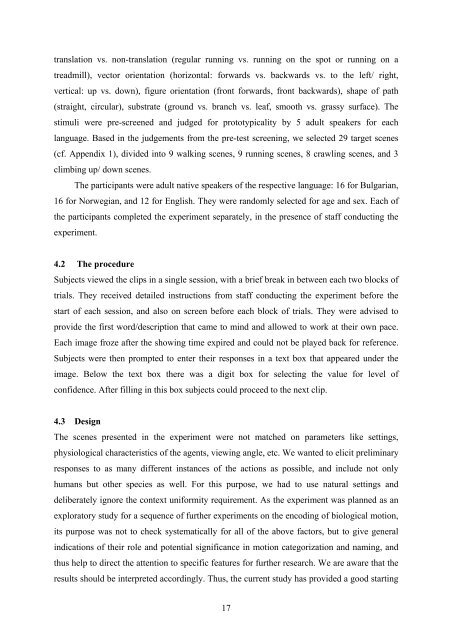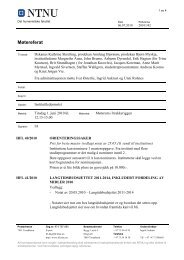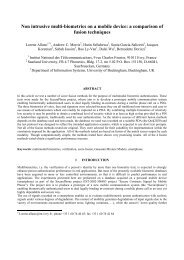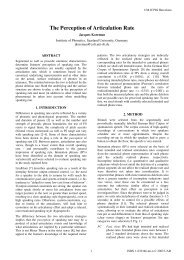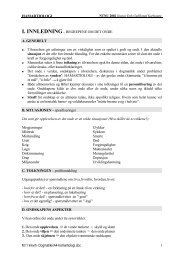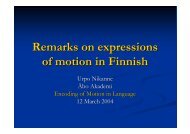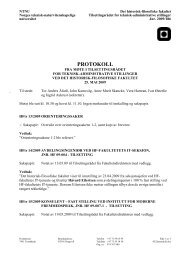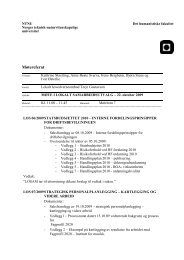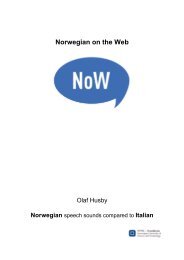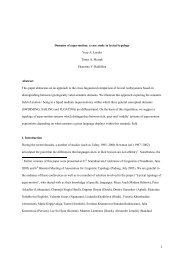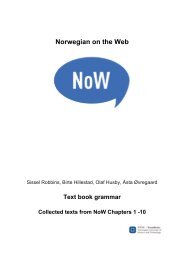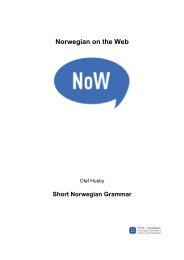In press: In: Dimitrova-Vulchanova, M - NTNU
In press: In: Dimitrova-Vulchanova, M - NTNU
In press: In: Dimitrova-Vulchanova, M - NTNU
You also want an ePaper? Increase the reach of your titles
YUMPU automatically turns print PDFs into web optimized ePapers that Google loves.
translation vs. non-translation (regular running vs. running on the spot or running on a<br />
treadmill), vector orientation (horizontal: forwards vs. backwards vs. to the left/ right,<br />
vertical: up vs. down), figure orientation (front forwards, front backwards), shape of path<br />
(straight, circular), substrate (ground vs. branch vs. leaf, smooth vs. grassy surface). The<br />
stimuli were pre-screened and judged for prototypicality by 5 adult speakers for each<br />
language. Based in the judgements from the pre-test screening, we selected 29 target scenes<br />
(cf. Appendix 1), divided into 9 walking scenes, 9 running scenes, 8 crawling scenes, and 3<br />
climbing up/ down scenes.<br />
The participants were adult native speakers of the respective language: 16 for Bulgarian,<br />
16 for Norwegian, and 12 for English. They were randomly selected for age and sex. Each of<br />
the participants completed the experiment separately, in the presence of staff conducting the<br />
experiment.<br />
4.2 The procedure<br />
Subjects viewed the clips in a single session, with a brief break in between each two blocks of<br />
trials. They received detailed instructions from staff conducting the experiment before the<br />
start of each session, and also on screen before each block of trials. They were advised to<br />
provide the first word/description that came to mind and allowed to work at their own pace.<br />
Each image froze after the showing time expired and could not be played back for reference.<br />
Subjects were then prompted to enter their responses in a text box that appeared under the<br />
image. Below the text box there was a digit box for selecting the value for level of<br />
confidence. After filling in this box subjects could proceed to the next clip.<br />
4.3 Design<br />
The scenes presented in the experiment were not matched on parameters like settings,<br />
physiological characteristics of the agents, viewing angle, etc. We wanted to elicit preliminary<br />
responses to as many different instances of the actions as possible, and include not only<br />
humans but other species as well. For this purpose, we had to use natural settings and<br />
deliberately ignore the context uniformity requirement. As the experiment was planned as an<br />
exploratory study for a sequence of further experiments on the encoding of biological motion,<br />
its purpose was not to check systematically for all of the above factors, but to give general<br />
indications of their role and potential significance in motion categorization and naming, and<br />
thus help to direct the attention to specific features for further research. We are aware that the<br />
results should be interpreted accordingly. Thus, the current study has provided a good starting<br />
17


